Configure Packet Capture to Optimize Performance on a Wireless Access Point
Available Languages
Objective
The Packet Capture feature enables capturing and storing packets received and transmitted by the Wireless Access Point (WAP). This feature is very useful for troubleshooting or performance optimization since the captured packets can then be analyzed by a network protocol analyzer .There are two methods of packet capture:
- Local capture method — Captured packets are stored in a file on the WAP. The WAP can also send the file to a Trivial File Transport Protocol (TFTP) server. The file Administration Packet Capture is formatted in pcap format and can be examined using packet analyzer software tools such as Wireshark and OmniPeek.
- Remote capture method — Captured packets are redirected in real time to an external computer running the Wireshark tool.
This article aims to guide you on configuring Packet Capture on a WAP and receive these packet captures locally or remotely. Once this is done, you can proceed with checking the packet capture status and then download the file.
Applicable Devices
- Wireless Access Points
Software Version
- 1.0.1.2 — WAP150, WAP361
- 1.0.2.2 — WAP351, WAP131
- 1.0.6.2 — WAP121, WAP321
- 1.2.1.3 — WAP371, WAP551, WAP561
- 1.0.0.17 — WAP571, WAP571E
Configure Packet Capture
Configure Packet Capture Settings
Step 1. Log in to the web-based utility of your access point and choose Administration > Packet Capture.
Note: The tabs may vary depending on the WAP model you are using. The images below are taken from WAP361.

Step 2. Verify if the Enable check box in Capture Beacons is checked. Beacon frames are transmitted periodically to announce the presence of a Wireless Local Area Network (WLAN). This feature is enabled by default.

Note: TheWAP551 and WAP561 capture three types of packets: packets associated to the wireless LAN, Ethernet LAN, and packets to internal interfaces.
Step 3. (Optional) If you want to enable a wireless Network Interface Card (NIC) to capture packets associated with a WAP, check the Enable check box of Promiscuous Capture. If you check this, skip to Step 6.

Note: Either the Promiscuous Capture or Radio Client Filter feature can be enabled.
Step 4. (Optional) If you did not check Promiscuous Capture and wish to enable a wireless NIC to capture packets without the need to associate with a WAP, check the Enable check box of Radio Client Filter.

Step 5. (Optional) If Radio Client Filter is enabled, enter the MAC address of the client filter in the Client Filter MAC Address field.

Step 6. Choose one of the following Packet Capture Method radio buttons below:
- Local File — Stores the captured packets as a file on the WAP. If this option is chosen, proceed to the next step.
- Remote — Redirects the captured packets in real time to an external computer that runs the network protocol analyzer tools. If this option is chosen, proceed to Step 10.

Step 7. (Optional) If Local File capture method is chosen, choose the interface for which the packets are to be captured from the Capture Interface drop-down list. The list of options may vary depending on the WAP model you are using.
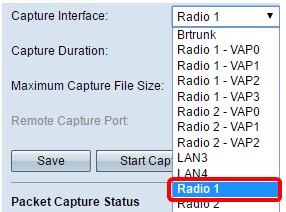
- Radio 1/Radio 2 — 802.11 traffic on the radio interface
- Ethernet/eth0 — 802.3 traffic on the Ethernet port
- Radio 1 - VAP0/Radio 2 - VAP0 — VAP0 traffic
- Radio 1 - VAP1 to Radio 1 - VAP3 (if configured) — Traffic on the specified Virtual Access Point (VAP)
- Radio 2 - VAP1 to Radio 2 - VAP3 (if configured) — Traffic on the specified VAP
- Radio 1 - WDS0 to Radio 1 - WDS3 (if configured) — Traffic on the specified Wireless Distribution System (WDS)
- Radio 2 - WDS0 to Radio 2 - WDS3 (if configured) — Traffic on the specified WDS
- LAN1 to LAN5 — 802.3 traffic on the Ethernet port
- Brtrunk — Linux bridge interface in the WAP device.
- wlan0vap1 to wlan0vap7 — Traffic on the specified VAP on Radio 1
- wlan1vap1 to wlan1vap 7 — Traffic on the specified VAP on Radio 2
- wlan0wds0 to wlan0wds3 — Traffic on the specified WDS interface
- VAP0 or WLAN0:VAP0 — VAP0 traffic
- WLAN1:VAP0 — VAP0 traffic on Radio 2 (for WAP561 devices only)
- wlan1 — VAP0 traffic on Radio 2
- Radio 1 - VAP1 to Radio 1 - VAP7 (if configured) — Traffic on the specified VAP
- Radio 2 - VAP1 to Radio 2 - VAP7 (if configured) — Traffic on the specified VAP
Step 8. Enter the capture duration ranging from 10 to 3600 seconds in the Capture Duration field. The default value is 60 seconds.
Note: In this example, 65 is used.

Step 9. Enter the maximum capture file size ranging from 64 to 4096 KB in the Maximum Capture File Size field. The default value is 1024 KB.
Note: In this example, 2048 is used.
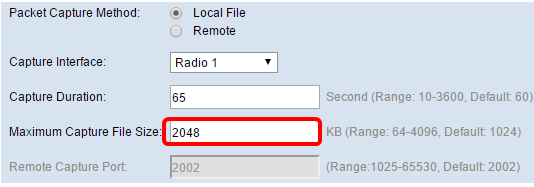
Step 10. (Optional) If Remote packet capture method is chosen, enter the port number ranging from 1 to 65530 in the Remote Capture Port field. The default value is 2002.

Step 11. Click Save.
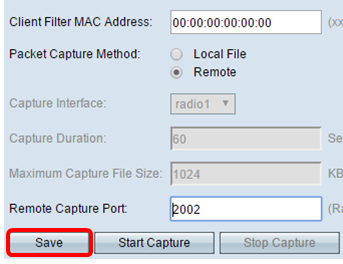
Step 12. Click Start Capture to initiate the packet capture process.
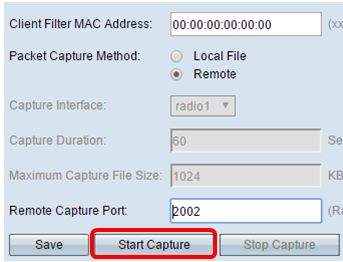
Step 13. Once the confirmation window pops up, click OK.

Note: The Packet Capture Status area will show that capture is in progress.
Step 14. (Optional) Click Stop Capture to stop the packet capture process then click OK.
You have now configured the Packet Capture settings.
Packet Capture Status
The Packet Capture Status area contains the following information. Click Refresh to view the recent status.
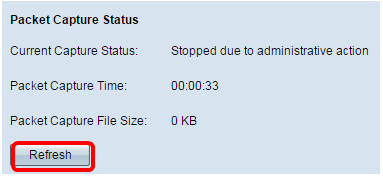
- Current Capture Status — Displays the current packet capture status.
- Packet Capture Time — Displays the duration for which the packets are captured.
- Packet Capture File Size — Displays the size of the packet captured file.
Packet Capture File Download
There are two ways on how to download the packet capture file.
- Hypertext Transfer Protocol (HTTP)
- Trivial File Transfer Protocol (TFTP)
Step 1. (Optional) If the captured file has to be downloaded through a TFTP server, check the Use TFTP to download the capture file check box. Once checked, the TFTP Server Filename and TFTP Server IPv4 Address fields will activate.
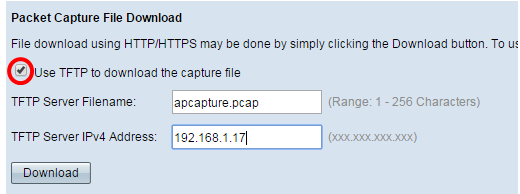
Note: If you did not check the check box in Step 1, skip to Step 4.
Step 2. Enter the file name in pcap format in the TFTP Server Filename field ranging from 1 to 256 characters.
Note: In this example, apcapture.pcap is used.
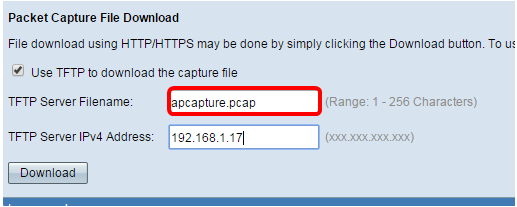
Step 3. Enter the IPv4 address of the TFTP server in the TFTP Server IPv4 Address field.
Note: In this example, 192.168.1.17 is used.
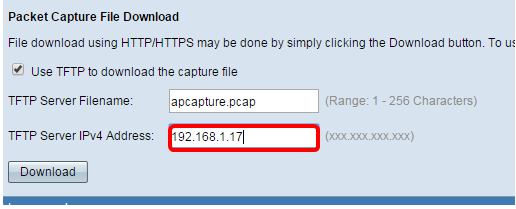
Step 4. Click Download.
Note: If you did not choose TFTP, the file is downloaded through HTTP/HTTPS.
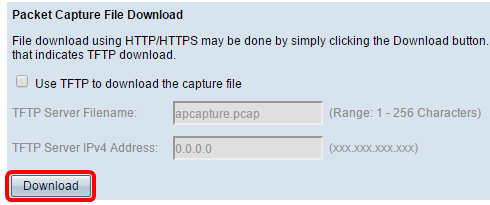
Step 5. A window appears to inform you that the download is in progress. Click OK.

You should now have downloaded your Packet Capture file through HTTP/HTTPS or TFTP.
Revision History
| Revision | Publish Date | Comments |
|---|---|---|
1.0 |
13-Dec-2018 |
Initial Release |
 Feedback
Feedback